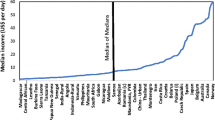Abstract
Changes in global patterns of grain production have affected the profitability of commercial, cash-crop agriculture in North America. The current financial crisis has highlighted a perceived conflict between the priorities of (1) strengthening net farm profit, (2) maintaining the productive potential of the land base, (3) enhancing the health and cohesiveness of the agricultural community, and (4) addressing societal demands for safe foodstuffs. Reducing input costs by reducing the need for privately owned machinery can minimize the scale-dependence of agricultural practices, as illustrated with examples involving silage and intensively managed pasture in Ontario. This approach could improve farming opportunities for nontraditional, part-time farmers, and at the same time, create a niche for professional custom operators and managers. Enhancing the viability of nontraditional farm operations, a historically neglected component of the farming community, as well as commercial farms is viewed as one approach to sustaining and improving both the agricultural land base and the agricultural community. Applying resource-extensive rather than resource-intensive approaches to forage management reveals that these apparently divergent priorities are, in fact, interlocking pieces of the same puzzle.
Similar content being viewed by others
References
Agricultural Council of Ontario. 1986. The incomes of farmers and their families in Ontario. Ontario Ministry of Agriculture and Food, Toronto.
Angers, D. A., B.D. Kay, and P.H. Groenevelt. 1987. Compaction characteristics of a soil cropped to corn and bromegrass.Soil Science Society of America Journal 51: 779–83.
Archer, J.R. 1986. Grassland manuring, past and present. InGrassland manuring, ed. J.P. Cooper and W.F. Raymond. Occasional Symposium No. 20, British Grassland Society, Lavenham Press Ltd., Lavenham, Suffolk, U.K.
Bidwell, O.W. 1986. Where do we stand on sustainable agriculture?Journal of Soil and Water Conservation 41: 317–20.
Boehje, M. 1986. A glimpse of the American agricultural scene.Farming Today (18 November).
Boehncke, E. 1985. The role of animals in a biological farming system. InSustainable agriculture and integrated farming systems, ed. T.C. Edens, C. Fridgen and S.L. Battenfield. East Lansing: Michigan State University Press.
Clark, E. Ann, and B.R. Christie. 1988. A forage-based vision of Ontario agriculture.Journal of Agricultural Ethics 1: 109–21.
Clark, E. Ann, Andy D. Macdonald, and Jock Buchanan-Smith. 1988.700 (800?) Ibs/acre live-weight gain?! 1987 update. Beef Research Report, OAC Pub. No. 586. Guelph, Ontario: University of Guelph.
Clark, E.H., H.J.A. Haverkamp, and W. Chapman. 1985.Eroding soils. Washington, D.C.: The Conservation Foundation. 252 pp.
Dermott, W. 1972. Effects of crops and grass on soil structure. InForage on the arable farm, ed. D.S. Kimber. Occasional Symposium No. 7. Hurley, Maidenhead, Berks: British Grassland Society.
Dube, Yvon. 1986. The right to a healthy environment.The Environmentalist 6: 185–96.
Fox, G. 1987. An economic assessment of the impact of alachlor deregistration on corn and soy-bean producers in Ontario.Canadian Journal of Agricultural Economics 35: 317–31.
Hallberg, G.R. 1986. From hoes to herbicides; agriculture and groundwater quality.Journal of Soil and Water Conservation 41: 357–64.
Hurnik, J.F. 1987.Welfare of farm animals. Proceedings of Bio-Ethics Conference, Montreal.
Ketcheson, J.W. 1980. Long range effects of intensive cultivation and monoculture on the quality of Southern Ontario soils.Canadian Journal of Soil Science 60: 403–10.
Macdonald, Andy D., and E. Ann Clark. 1987. Water and quality loss during field drying of hay.Advances in Agronomy 41: 407–38.
Nation, H.A. 1986. Grass—the next Cinderella crop. Annual Meeting, Society for Range Management, Orlando, Fla.
Ontario Ministry of Agriculture and Food. 1986.Farm business management handbook. Toronto.
Pasour, E.C., Jr. 1988. The farm problem, government farm programs, and commercial agriculture.Journal of Production Agriculture 1: 64–70.
Pedersen, T.T., and R. Vind. 1985.The total harvest. Trans. ASAE, Paper No. 85-1032. East Lansing: Michigan State University.
Pimental, D., J. Allen, A. Beers, L. Guinand, R. Linder, P. McLaughlin, B. Meer, D. Musonda, D. Perdue, S. Poisson, S. Siebert, K. Stoner, R. Salazar, and H. Hawkins. 1987. World agriculture and soil erosion.Bioscience 37: 277–83.
Pollock, W.E., and J.G. Proulx. 1986. Finishing beef on silage in northern Ontario.OMAF Highlights 9: 4–7.
Royal Society. 1983.The nitrogen cycle of the United Kingdom. A study group report. London, 101–2.
Sparrow, H.O. 1984.Soil at risk; Canada's eroding future. Ottawa: Standing Committee on Agriculture, Fisheries, and Forestry to the Senate of Canada.
Spedding, C.R.W., J.M. Walsingham, and A.M. Hoxey. 1981. Biological efficiency. InBiological efficiency in agriculture, Chap. 1. London: Academic Press.
Spiers, R.B., and C.A. Frost. 1987. Soil water erosion on arable land in the United Kingdom.Research and Development in Agriculture 4: 1–11.
Stevenson, F.J. 1982. Origin and distribution of N in the soil. InNitrogen in agricultural soils, ed. F.J. Stevenson. Agronomy Monograph No. 22. Madison, Wis.: American Society of Agronomy.
Tetteh, J.P. 1984. Selection for forage quality in alfalfa (Medicago sativa L.). Ph.D. Diss. University of Guelph, Guelph, Ontario.
Thompson, L.M. 1988. Effects of changes in climate and weather variability on the yields of corn and soybeans.Journal of Production Agriculture 1: 20–27.
Veira, D.M., A. Fortin, M. Ivan, G. Butler, and J.G. Proulx. 1983. Performance of Hereford × Shorthorn bulls and steers raised in northern Ontario and fed different levels of grass silage and high moisture barley.Canadian Journal of Animal Science 63: 861–69.
Vogtmann, H. 1985. Biological agriculture in Europe. InSustainable agriculture and integrated farming systems ed. T.C. Edens, C. Fridgen, and S.L. Battenfield. East Lansing: Michigan State University Press.
Wagstaff, H. 1987. Husbandry methods and farm systems in industrialised countries which use lower levels of external inputs: a review.Agriculture, Ecosystems, and Environment 19: 1–27.
Author information
Authors and Affiliations
Rights and permissions
About this article
Cite this article
Ann Clark, E. Resolving conflicting priorities in Ontario agriculture. Journal of Agricultural Ethics 1, 275–289 (1988). https://doi.org/10.1007/BF01826792
Issue Date:
DOI: https://doi.org/10.1007/BF01826792




